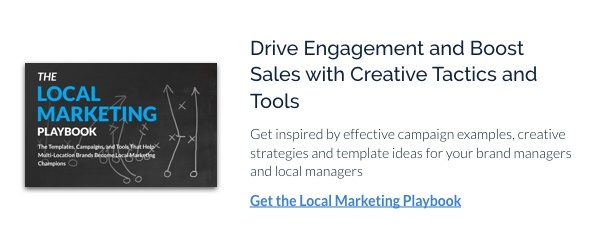Amalia, a small-town franchisee of an internationally-known brand, stared at her operations spreadsheets and sighed quietly. It had been a rough quarter, and she needed to increase sales yesterday. Her regional marketing manager kept telling her that her market demographics were changing, and it was affecting her overall sales. In Amalia's opinion, the location wasn’t the whole story. The real problem was the fact the brand management team kept re-running the same campaigns quarter after quarter when what Amalia really needed was some advertising that would attract new customers.
Tyrone, Amalia’s regional marketing manager, sighed. He was under massive pressure from his brand manager Julia to deliver “insights” for data-driven decision-making. While Tyrone understood what the brand management team was after, the pressure to deliver weekly reports on distributed marketing performance for stores in the Tri-State area was easier said than done when he had to manually download reports from five different systems to show why the top 10 percent of stores were doing so much better than the other 90 percent.
Julia, a brand manager at corporate HQ, hundreds of miles away from Tyrone and Amalia, resisted the urge to walk out of the office from sheer frustration. She couldn’t keep her design team on-track to meet the deadline from the CMO for the new brand launch ahead of the annual franchisee convention. She knew what the problem was — an endless stream of one-off requests from franchisees. Each time a new request came in, the design team's progress was interrupted, and requests for revisions were far too common. Even though it was “only” an hour here and there, the impact on her team’s productivity was real and she could tell morale was dropping due to stress.
While you may not actually know Amalia, Tyrone, or Julia, you're probably familiar with the struggles they face. Each of them knows that the team is in trouble, and being held back by their current process. Here, we'll dive into the warning signs, and how to know if your team could benefit from a digital asset management solution.
12 Signs Your Brand Needs a Digital Asset Management Solution
So what is Digital Asset Management (DAM)?
DAM tools are a category of software that allow brands to store, organize and retrieve their assets digitally. For individuals like Amalia, Tyrone, and Julia; DAM can solve key challenges associated with distributed models by providing access according to individual need.
To learn more about DAM, check out the following Pica9 resources:
- Digital Asset Management Software for Enterprises: 7 Massive Benefits
- The Best Digital Asset Management Software for Distributed Marketing
- 4 Ways to Successfully Implement a Digital Asset Management System
So far, Amalia, Tyrone and Julia are all having pretty bad days. Amalia wants to grow her store's sales. Tyrone wants to report accurately on those results. Julia wants to increase efficiency at headquarters, so her design team can spend more time creating the innovative campaign concepts that franchisees actually want. Whether they know it or not, all three of our friends could actually be remarkably good candidates for a piece of technology that's designed to solve the pain points they're feeling across the board: DAM. Even though they may not yet realize it, there are key signs for each of them that they’re in desperate need of a unified technology for managing their marketing assets.
Let's get back to Amalia, Tyrone, and Julia to see what's causing their problems:
The Franchisee: Amalia
Sign #1: Depressed Margins
Amalia can’t move product off her shelves quickly enough. In fact, even though she does her absolute best to order the right quantities to match demand in her market, she’s constantly dealing with wasted shelf space, and even worse, food items that have to be written off due to rapidly-approaching expiration dates. While Amalia has been taking Tyrone’s recommendations to only re-order products that are being promoted in the latest brand advertising campaigns, the ads aren’t driving foot traffic. Amalia knows what her local customers like, and she wants to promote menu items that match local tastes, sometimes regardless of what's running nationally. But without that flexibility she's seeing more of her stock go to waste and more of her hard-earned margins erode right along with it.
Sign #2: Lower Store Traffic
These days, Amalia never knows whether she should expect a line out the door or crickets. While there are key times of the day that are usually steady, there is no easy way for her to capitalize on the patterns that she sees. This is because she doesn't have the resources to adapt quickly to act on the opportunity.
With less traffic than she would like to her location, and less traffic during times that have historically been busy, she needs effective advertising more than ever. She suspects her location's shift in demographics has also contributed to lower sales — yet, still feels like the campaigns coming from head office aren't resonating with her target market.
Sign #3: Declining Local Sales
Q1 was amazing at Amalia’s store, and Q2 was nearly as good. This month, however, sales are suddenly dropping sharply and the revenue margins (see above) are in the gutter. After a career spent in the restaurant industry, Amalia knows just how risky it is to fall to the back of the pack among local franchisees. She’s seen how viciously a business can contract when sales begin to decline, and she worries that if this trend continues she’ll be out of business before the year is out. At other restaurants that she has run, she knows that local partnerships can be the perfect way to get out of a funk. But, with this brand she doesn't have the tools at her disposal to run a partnership program on her own.
Struggling to support your local marketing teams? Get The Local Marketing Playbook for tools, tips, campaign ideas, and more to help support your local affiliates.
The Regional Marketing Representative: Tyrone
Sign #4: Too Much Time Creating Reports
Tyrone knows marketing, and as a lifelong resident of the Tri-State area, he also understands the local customer base in a way that Julia and the brand management team at headquarters don't. Unfortunately, the fact he’s spending over an entire day each week on manual reporting is really limiting his ability to communicate with struggling local franchisees, like Amalia, or the brand management team.
Tyrone hates the fact that he has to use five or more different systems and data sources to pull out sales data for his region. Even after compiling data and painstakingly checking its quality, he’s still not sure that he’s telling the full story: Which marketing activities are actually driving results for his local franchisees? If he had more time to think about what the data was saying (and less time collecting it) he'd have the answer already.
Sign #5: Ineffective Communication of Local Marketing Insights
Tyrone doesn’t have the time or means to communicate what he considers need-to-know information to local franchisees. He’s been hired to act as a local expert and buffer between the brand management team and store owners, and Tyrone hates the fact that he feels like he’s doing his job ineffectively. In some cases, he’s struggling because he doesn’t have the hours each week needed for one-on-one coaching with all of the franchisees across three states. In other, more disappointing cases, Tyrone’s efforts to reach out to struggling store owners have been dismissed or ignored. The worst part? Tyrone's boss just sent him an email with a complaint forwarded from a local affiliate stating that they hadn't heard anything from their regional support in months.
Tyrone has a knack for the types of social media campaigns, coupons, and out of home (OOH) advertising that Tri-State customers will love. He knows that if his knowledge is combined with the local store owners' understanding of their customers, the result will be positive. However, until he figures out how to clone himself three or four times, he’s stuck between a rock and a hard place; or rather a brand management team and frustrated local representatives.
If this sounds familiar, you may want to check out our recent blog post about Local Marketing Chaos.
Sign #6: Local Revenue Performance Limits
Tyrone’s favorite part of his job is when he successfully coaches franchisees like Amalia, who may know the food industry but not all the ins and outs of marketing, to success. As he stares at his spreadsheets of regional sales data, Amalia and a few other stores are on his mind. Unfortunately, it seems like no matter what he or they do, the stores in his market just aren't able to reach their full revenue potential. No matter what he suggests, it seems like the vast majority of locals are unable to push their revenue past a certain threshold.
Brand Manager: Julia
Sign #7: Delays and Missed Deadlines
Julia never misses a deadline. She hates the fact that her creative team is always running behind, and she knows it’s down to all the requests they get from local store owners like Amalia. Julia hates the fact that deadlines for important objectives, like the desperately-needed brand facelift her designers want to be working on, are taking a backseat to ad hoc requests from franchisees. She's seeing deadlines getting pushed back by days — and then weeks. She's getting heat from her boss about slow turnaround time, and progress.
Sign #8: Overworked, Frustrated Creatives
It's no secret what burnout looks like among graphic designers and other in-house creative professionals at headquarters. Julia’s watched her team take longer coffee breaks, ask for work-from-home days more frequently and take personal time off. Productivity is dropping — she sees her designers staring at their Macs with defeated expressions well past 7 p.m. some days.
While Julia isn’t a creative herself, she’s spent her career among creative people and knows that burned out designers don't create campaigns that win awards or resonate with customers. She’s worried that her designers are more likely to produce an award-winning resume, and head to the competition, than any award winning creative from what they're working on now.
Sign #9: Inconsistent Local Branding
Julia doesn’t have the time to monitor every last thing that local marketers are doing. While that technically falls under Tyrone’s responsibilities, Julia’s efforts to check up on local compliance have also proved remarkably disappointing. Every time she looks at a local store’s Facebook page, or photographs of in-store signage, she sees marketing materials that misrepresent the brand she's worked so hard to protect.
Julia never understands how local franchisees like Amalia get from point A to point B. It’s a total mystery how her carefully-crafted briefs to the design team can go completely out the window the minute a franchisee comes up with an idea; and the result is signage written in Comic Sans for goodness sake!
Marketing Executive: Martha
Sign #10: Declining Brand Awareness
Martha, who you haven't met yet, is the fourth character in our saga. The Chief Marketing Officer, Martha deals with big picture stuff. Her data science team reports that brand awareness metrics, based on everything from social listening to consumer feedback surveys, are revealing that customers are defecting to the competition in waves. Even more concerning, the measure of business value that she's in charge of, brand equity, is also in decline.
For more on brand equity, we recommend Why Brand Equity Marketing Matters for Local Partners of Big Brands.
Sign #11: Stagnant Revenues
Martha shares Tyrone’s frustrations around the mysterious cap that seems to hover over her franchisees, limiting their potential for revenue and profitability. From the reports that she gets from her regional marketing teams, she knows that the restaurants should be growing at a faster rate. However, too often these stores are unable to cross the threshold and grow revenues at a faster rate. As a result, profitability was stagnant last quarter and showing signs of decline this quarter. Martha knows that more targeted marketing and a brand refresh could result in a lift, but she’s frustrated that the creative team is rarely meeting deadlines.
Sign #12: Shrinking Franchisee Network
Martha’s faced with one of the scariest signs of impending disaster that a CMO at a distributed brand could ever face; a shrinking network of local franchisees. With less confidence in the brand’s ability to support and empower them, potential affiliates are less willing to sign on. She’s concerned that stores in decline, like Amalia’s, will go out of business; or de-flag and reopen as an independent restaurant — both of which would further damage brand equity.
Are These Distributed Marketing Pros All Doomed?
All of these characters are missing something, which is a shared roadmap for distributed marketing success. While none of them currently realize it, here’s how the story ends:
Martha starts researching to find a solution, and discovers evidence that DAM tools could reverse some of the more concerning trends at the brand. More importantly, she discovers case studies that support the value of a specialized kind of DAM, with local marketing automation (LMA) features designed specifically for the challenges of a franchised organization.
Fast forward six months after the brand implements a DAM with strong LMA and templating capabilities, and let’s check in with our cast of characters:
The Franchisee: Amalia
Amalia beams as she reviews yet another glowing, 5-star review of her restaurant on Yelp. She can barely believe that just six months ago she was seriously considering shutting it down. Thanks to the new technology her brand implemented, she’s gained the ability to create advertising on-demand — allowing her to create campaigns in real time.
Amalia logs into her dashboard, and clicks to select a print template for a new window sign. Using brand-approved images, she’s able to create an offer that features the local high school football team mascot and send it to her local printer in less than 10 minutes. Even though she’s never taken a single class on graphic design, she knows it’s going to look great. Thanks to the local marketing automation tool and DAM that help her create professional-looking advertising, Amalia’s finally gained the freedom to create content that is relevant to her local customers, which means she's building greater loyalty.
The Regional Representative: Tyrone
Tyrone hangs up his iPhone, and carefully reviews the results on his reporting dashboard. He smiles, remembering that less than a year ago he was spending nearly two work days each week in Excel-graphing purgatory. Thanks to the new DAM tool, Tyrone no longer has to reconcile confusing data from multiple systems. There’s no more guess work about what’s really going on at the local level - and he's able to figure out exactly what's working and what isn't.
The built-in reporting capabilities allow him to quickly view the marketing and profitability results for his entire region, sub-regions, and for individual stores. He can track results by quarter, campaign, or even individual templates or assets. He no longer has to manually email reports to headquarters and bite his nails waiting for a response. Tyrone is in love with his job, because he can see actual results, and translate that intelligence into ideas for the home office and his local franchisees.
The Brand Manager: Julia
Julia’s design team hasn’t missed a deadline in six months. While she knows she’ll probably never see the day when ad hoc requests from franchisees are completely a thing of the past, her team has gone from dozens each day to just a few per week. When she does hear from Amalia and other franchisees, she’s given helpful feedback about email and print marketing templates that help her prioritize what's next.
Since she’s no longer busy worrying sick about her designers burning out, Julia’s got plenty of time to interface with her regional marketing representatives and review her super-helpful reports. Thanks to the templating features in her new DAM, distributed brand consistency has gone from a pipe dream to reality — even across hundreds of locations. Best of all, Julia is finally able to use actual data intelligence on local marketing results to shape next quarter’s campaign strategy.
The Executive: Martha
Martha clicks through her PowerPoint presentation one final time, prepared to present the quarter’s results to the board of directors. She couldn’t feel better about the recommendation she made six months ago to invest in DAM with LMA capabilities, and how far the brand’s profitability, equity metrics, and franchisee satisfaction have come in the past six months. Prepared to recommend that they invest in growing the franchise network aggressively again, Martha knows their equity and customer loyalty has nowhere to go but up.
Solving Your Own Distributed Marketing Pain Points with DAM
Whether you identify with Martha, Julia, Tyrone, or Amalia, you’re far from alone. Distributed marketing challenges span industries, and many are attributable to a lack of a shared technology. By taking a clue from this proverbial, multi-location restaurant brand, you can see there is a solution to decreased profitability, brand equity loss, and rapidly-declining local sales. If you identify with one or more of the twelve signs listed here — including lower store traffic, frustrating manual reporting, missed deadlines, or unhappy franchisees —there’s a good chance your brand needs a distributed marketing platform like a DAM.
For more insights on how the most successful multi-location brands like Marriott, Polaris, Adecco, and The Melting Pot scale marketing efficiency from the C-Suite to the local representative level, get: Distributed Marketing on Steroids: The Brand Manager’s Guide to Designing and Managing Local Marketing Assets Without Breaking a Sweat 




